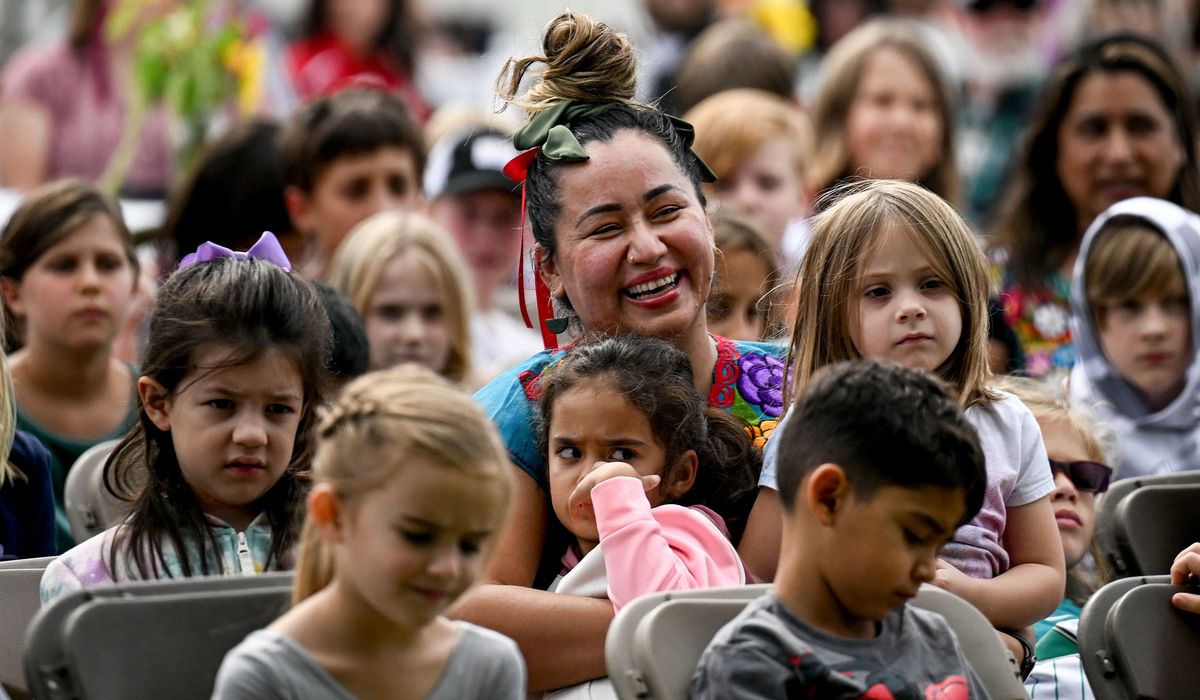First public dual language school opens in Spokane County; Washington may get more

Now adorned in a fresh coat of paint, with crayon artwork pasted to hallways, signs in English and Spanish, and the racket of kids shooting hoops outside, the former Pratt school building in East Spokane is abuzz with energy.
It’s hard to imagine the building vacant, as it was before the staff and students of Ruben Trejo Dual Language Academy took up residence in the facility.
The building’s previous occupant was Pratt Elementary, which closed in 2007, and it’s since been the site of various alternative programs in Spokane Public Schools.
This year, Spokane County’s first standalone dual language school moved into the vacant space after outgrowing the building they shared with other programs in the school district.
The school, where teachers use 50/50 English and Spanish to instruct core subjects, held a ribbon cutting to inaugurate its new building and with it their identity as a standalone school. The school is named in honor of local Chicano artist Rubén Trejo, who taught at and founded the Chicano studies department at Eastern Washington University.
“I’m so proud of the recent work of naming schools after people with Spokane connections, with inspiring stories and from diverse backgrounds,” said school board president Nikki Otero Lockwood, who proposed the school be named for Trejo. “The board hopes and believes this instills in our students the respect for diverse backgrounds and contributions, and you can be from Spokane and do amazing things, either locally or nationwide.”
Parents of the nearly 300 enrolled in the school are excited about the life skills and cultural exposure their kids get at the option school.
Martin Zepeda, father of two Trejo students, sees stark differences from his schooling and that of his kids. The son of two Mexican Immigrants, Zepeda didn’t speak English when he enrolled in kindergarten. He described a “culture shock” at being fully surrounded by English, foreign to him until he quickly picked up the language and now speaks both fluently.
“We were just kind of thrown in there,” Zepeda recalled. “In kindergarten, I didn’t know a lick of English, and you kind of had to swim and survive.”
Previously employed as a translator, he wants his kids to have the same edge he has over monolingual counterparts in the job market. Also, with family still in Mexico, it allows Zepeda’s kids exposure to the language and culture while still in their Spokane community.
“My son and daughter are Americanized in a sense, so they don’t get that,” he said. “The only time they see that is when we travel abroad or when we go visit my parents.”
Some kids also already have their careers at the top of mind when they practice Spanish. Sixth-grader Georgina Hughes works to refine her “Spanglish,” slang for a conversational Spanish/English hybrid, into a refined Spanish she can use in her future career as a spy for the CIA.
“It’ll probably help me when I’m older to get a really good job,” she said.
The instruction will also help her connect with her mom’s side of the family, many of whom live in the Dominican Republic and speak mostly Spanish. She also relishes that she can out-Spanish her English-speaking father.
At the ribbon cutting, guests were hungry for more than just the provided red velvet sheet cake decorated with a smiling axolotl, the school’s mascot. Proud to have his kids exposed to the language, Zepeda said dual language programs should exist throughout the district. He’d also like to see the Trejo school use more Spanish during the day to build confidence and comfort in his kids.
“We understand that there’s going to be struggles for the kids, because honestly, my kids don’t like speaking Spanish,” he said. “They communicate with their buddies in English and in our home, that’s the first language, so that’s what they speak, that’s what they’re comfortable with.”
Current state superintendent Chris Reykdal also seeks to expand dual language offerings in the state. He’s made it his office’s mission to establish by 2030 at least one dual language elementary school in each of the 295 school districts in the state, if they want one.
He said he plans to continue seeking and distributing grants to interested schools to help their programs get their feet off the ground.
Now, 40 school districts in the state include a dual language school, totaling more than 130 schools enrolling more than 50,000 students. These schools teach in Spanish, Russian, Mandarin, Japanese and Vietnamese.
They’re primarily concentrated on the West Side, though Pasco School District started the school year with dual-language programs in each of its 17 elementary schools.
He also intends to continue outreach with Latino communities to get more native Spanish-speaking kids and families enrolled in these programs to reverse the narrative that kids must prioritize English over their native Spanish in order to be successful in school. In a dual-language school, their Spanish fluency is a clear asset.
“This flips this on its head and says, ‘Dear 5-year-old, the second you walk in, we so need you to speak Spanish,’ ” Reykdal said. “Because we’ve got an English speaker that needs your language, and you’re going to need their language.”